
















AERONAUTICAL SOCIETY OF SOUTH AFRICA INTERVARSITY CHALLENGE
By Garth Calitz
Saturday 16th November saw the annual Intervarsity Aerospace Challenge hosted by The South African Air Force Museum at AFB Zwartkop.
The goal of the competition is to conceptualise, design, construct and fly a radio controlled model aircraft capable of taking off under its own power and flying as fast as possible over a short course while carrying a pre-specified payload, in this case a full 330ml Coke can. The models had to be designed so that the cool drink could easily be added just before flight without excessive reassembly. Every model was extensively scrutinised before flight to make sure that they were within the specifications of the competition and any aircraft which was deemed by the judges to be a danger to the competitors or spectators was immediately disqualified.
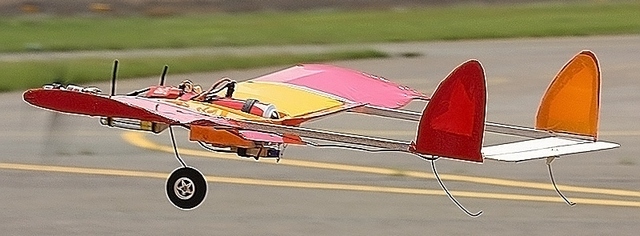
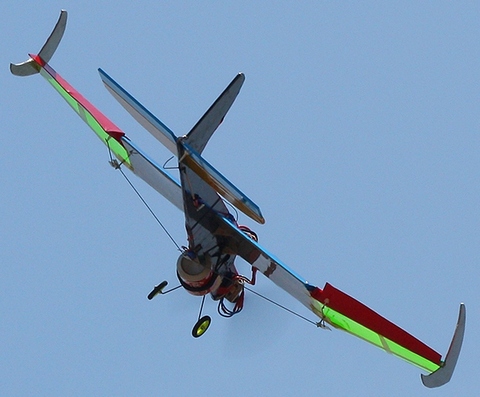
Some interesting design concepts
The specifications were developed to test the students design abilities to the limit, any aircraft entered in the competition must be an original design; no major components from existing model aircraft such as wings, fuselage or tails were permitted thus encouraging the students to "think outside the box". The maximum allowable empty aircraft mass was 2.5 kg including any weights required to achieve balance for the aircraft. With a maximum current draw of 15 amps and a power source limited to a 3 cell Lithium Polymer (LiPo) battery all designs had to be super efficient. The maximum wing span of the model was limited to 1500 mm there was no limit on the length of the fuselage. Designs are limited to fixed-winged aircraft configurations only and the aircraft must fly largely on the aerodynamic effects of its wings. The mass of the aircraft may not be altered during take-off or flight. Aircraft geometry changes (flaps, wing sweep etc.) are allowed providing it is brought about by remote control. All aircraft had to be piloted by a SAMAA approved pilot thus levelling the playing field as much as possible.

Some of the entries
The university teams had to produce an A1 sized poster for judging. This poster had to cover the choice of design concept (with some structural analysis), performance prediction and stability and control predictions. The poster was to be scored out of 100 points and the points were made up as follows:
Design concept 30 points
Performance prediction 30 points
Stability and control predictions 30 points
Poster layout and appeal 10 points
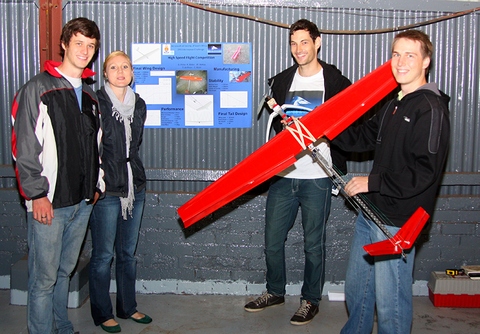
Team Mirage with their aircraft and poster
All teams were to demonstrate their aircraft's ability to take off and within 30 seconds, fly in a controlled manner in a figure eight around a course of 150 m as fast as possible without a substantial height change. Each team was allowed three attempts. The best flight time formed the official flight score for each team. The flights were scored out of 100 points. The fastest time of any team was awarded 100 points and the remainder calculated on a pro rata basis. Unfortunately many of the entrants battled to complete even one attempt as they had to contend with winds that were gusting to 30 knots which caused many aircraft to crash.
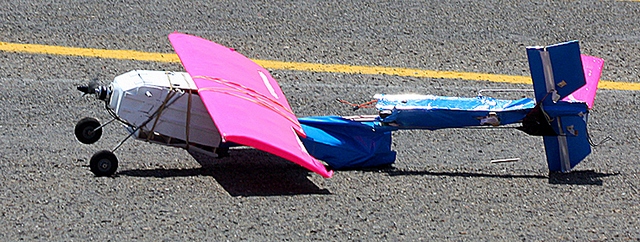
One of the unfortunate entries
Teams University of Pretoria walked away with the lion's share of the awards taking best poster, fastest flight and best design.
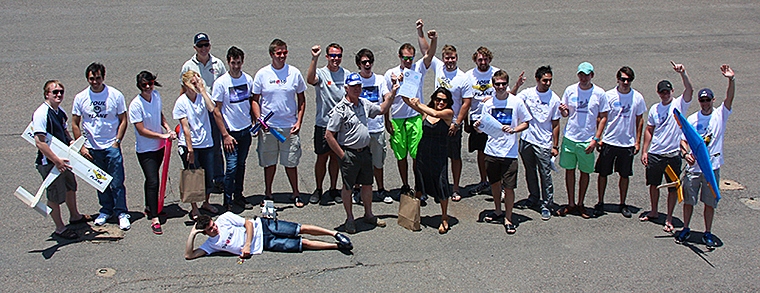
The University of Pretoria Team
The overall winner was an aircraft designed and built by the "Mirage" team with a total score of 169.
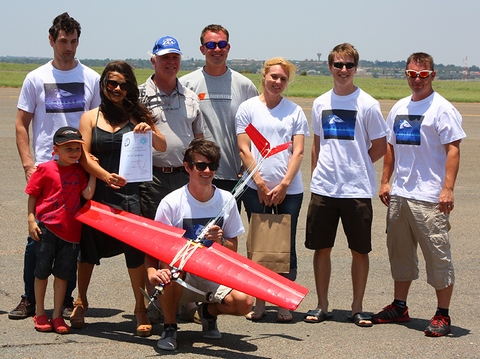
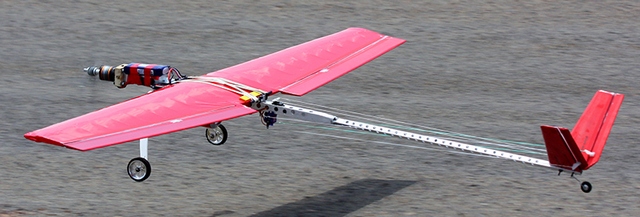
The Mirage team and their winning aircraft
The Mirage team was followed closely by the "Soul Plane" (145 points) and the "Panic Mechanics" (123 points).
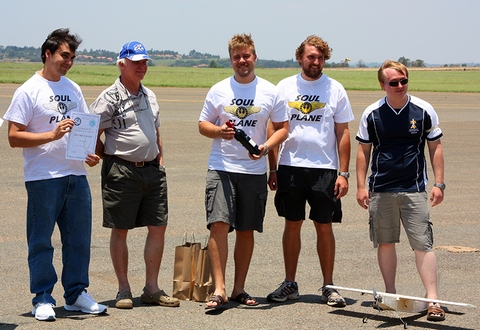
The Soul Plane team
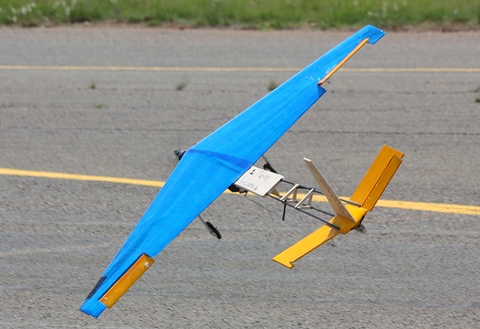
The Panic Mechanics entry
The top three teams were the only teams that managed to successfully complete the flying stage of the competition.
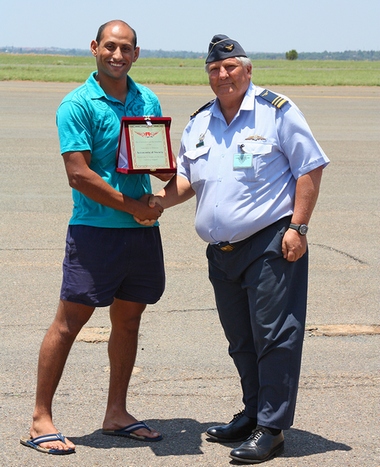
The Chairman of the University of Pretoria Aeronautical Society David Tsoma handed over a plaque to Lt.Col. Clive Sheppard thanking the SAAF Museum for all the assistance showed them over the years.
The goal of the competition is to conceptualise, design, construct and fly a radio controlled model aircraft capable of taking off under its own power and flying as fast as possible over a short course while carrying a pre-specified payload, in this case a full 330ml Coke can. The models had to be designed so that the cool drink could easily be added just before flight without excessive reassembly. Every model was extensively scrutinised before flight to make sure that they were within the specifications of the competition and any aircraft which was deemed by the judges to be a danger to the competitors or spectators was immediately disqualified.


Some interesting design concepts
The specifications were developed to test the students design abilities to the limit, any aircraft entered in the competition must be an original design; no major components from existing model aircraft such as wings, fuselage or tails were permitted thus encouraging the students to "think outside the box". The maximum allowable empty aircraft mass was 2.5 kg including any weights required to achieve balance for the aircraft. With a maximum current draw of 15 amps and a power source limited to a 3 cell Lithium Polymer (LiPo) battery all designs had to be super efficient. The maximum wing span of the model was limited to 1500 mm there was no limit on the length of the fuselage. Designs are limited to fixed-winged aircraft configurations only and the aircraft must fly largely on the aerodynamic effects of its wings. The mass of the aircraft may not be altered during take-off or flight. Aircraft geometry changes (flaps, wing sweep etc.) are allowed providing it is brought about by remote control. All aircraft had to be piloted by a SAMAA approved pilot thus levelling the playing field as much as possible.

Some of the entries
The university teams had to produce an A1 sized poster for judging. This poster had to cover the choice of design concept (with some structural analysis), performance prediction and stability and control predictions. The poster was to be scored out of 100 points and the points were made up as follows:
Design concept 30 points
Performance prediction 30 points
Stability and control predictions 30 points
Poster layout and appeal 10 points

Team Mirage with their aircraft and poster
All teams were to demonstrate their aircraft's ability to take off and within 30 seconds, fly in a controlled manner in a figure eight around a course of 150 m as fast as possible without a substantial height change. Each team was allowed three attempts. The best flight time formed the official flight score for each team. The flights were scored out of 100 points. The fastest time of any team was awarded 100 points and the remainder calculated on a pro rata basis. Unfortunately many of the entrants battled to complete even one attempt as they had to contend with winds that were gusting to 30 knots which caused many aircraft to crash.

One of the unfortunate entries
Teams University of Pretoria walked away with the lion's share of the awards taking best poster, fastest flight and best design.

The University of Pretoria Team
The overall winner was an aircraft designed and built by the "Mirage" team with a total score of 169.


The Mirage team and their winning aircraft
The Mirage team was followed closely by the "Soul Plane" (145 points) and the "Panic Mechanics" (123 points).

The Soul Plane team

The Panic Mechanics entry
The top three teams were the only teams that managed to successfully complete the flying stage of the competition.

The Chairman of the University of Pretoria Aeronautical Society David Tsoma handed over a plaque to Lt.Col. Clive Sheppard thanking the SAAF Museum for all the assistance showed them over the years.
 |
 |
 Copyright © 2024 Pilot's Post PTY Ltd
The information, views and opinions by the authors contributing to Pilotís Post are not necessarily those of the editor or other writers at Pilotís Post.
Copyright © 2024 Pilot's Post PTY Ltd
The information, views and opinions by the authors contributing to Pilotís Post are not necessarily those of the editor or other writers at Pilotís Post.